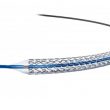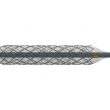Courtesy of Dr. Leiva. Bioresorbable scaffolds with drug-eluting stents (bioresorbable vascular scaffolds, BVS) have been added to the list of endovascular treatment options for coronary disease. The ABSORB III trial showed the non-inferiority of this stent type to everolimus-eluting metallic stents as regards target-lesion revascularization (TLR) at one year. However, reports have suggested a higher...
Proximal anterior descending artery angioplasty: what are its long-term outcomes?
Courtesy of Dr. Javier Castro. Certain coronary lesions have been historically discouraged for endovascular treatment. Among these can be found left main coronary artery lesions, multivessel disease, and proximal anterior descending artery lesions. As a matter of fact, the latter is actually considered separately as a criterion for choosing the revascularization method. Endovascular treatment of...
FFR-Guided ACS Revascularization Apparently Superior to Culprit Vessel Treatment
Using fractional flow reserve (FFR) to guide revascularization of all functionally significant lesions in the setting of acute coronary syndrome appears to improve outcomes over treating only the culprit artery, according to the Compare-Acute trial. This study, conducted at 24 centers in Europe and Asia, enrolled 885 patients who were stable following successful primary angioplasty and...
Surgery or TAVR in intermediate risk? Results of the SURTAVI Study
Courtesy of Dr. Gustavo Leiva. Transcatheter aortic-valve replacement (TAVR) with the use of a self-expanding prosthesis is superior to medical therapy in patients with severe, symptomatic aortic stenosis in whom surgical aortic-valve replacement has been associated with prohibitive risk. Among patients considered at high risk, TAVR may be an alternative to surgery. The comparative...
Pregnancy and Risk of Spontaneous Coronary Artery Dissection: How to Proceed
Courtesy of Dr. Pablo Baglioni. Between the years 2000 and 2015, the authors of this article searched for reports on spontaneous coronary artery dissection (SCAD) in pregnant or immediate post-partum women aiming at defining the clinical characteristics of this pathology and offering management recommendations. Information on 120 women was analyzed; 116 were between 22...
Biolimus and Everolimus Eluting Stents in Coronary Artery Disease: Similar Safety?
Courtesy of Dr. Guillermo Migliaro. Events such as very late stent thrombosis and restenosis after first generation DES stenting were associated to the inflammatory response of site implantation. The presence of a durable or permanent polymer was thought to play a central role in said inflammatory process, which caused, among other things, delayed re-endothelialization and...
Percutaneous Mitral Annuloplasty: First Results in Humans
Courtesy of Dr. Agustín Vecchia. In the last few years, new percutaneous treatment options for mitral regurgitation have emerged. Transcatheter mitral annuloplasty with various devices is a relatively simple procedure that could compress the origin of circumflex artery branches due to the different orientation of mitral corners and the coronary sinus. The following work by Park...
Incomplete Revascularization: Increased Events Rate in Non-Cardiac Surgery?
The aim of this study was to determine whether incomplete revascularization is associated to higher adverse events risk and acute myocardial infarction in patients undergoing non-cardiac surgery. Coronary artery disease patients or patients with prior PCI often have non cardiac surgery. These patients may have had all obstructions treated before surgery (complete revascularization) or...
Zotarolimus with Durable Polymer vs. Biolimus with Biodegradable Polymer
The present work compared the safety and efficacy of the permanent polymer zotarolimus eluting stent vs. the biodegradable polymer biolimus eluting stent in unselected coronary artery disease patients. The biodegradable polymer biolimus eluting stent resulted superior to the first generation durable polymer stent in long term randomized studies. However, little evidence supports this superiority...
RESOLUTE Global: 5 Years of Zotarolimus DES Stenting
This study assessed the cumulative incidence of cardiovascular evens after zotarolimus eluting stent implantation. Individual studies often lack enough statistical power to show differences in low frequency adverse events. The Resolute zotarolimus eluting stent was evaluated across 10 prospective clinical trials designed with identical adverse events definitions. The Global Resolute clinical trial program...









